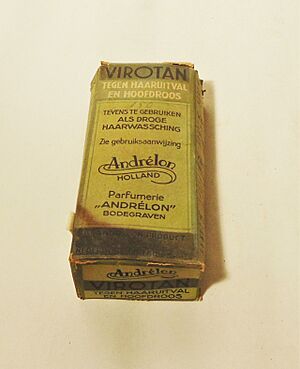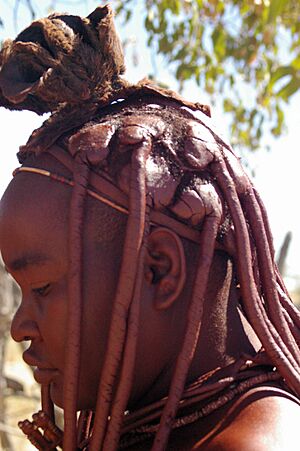Dry shampoo facts for kids
Dry shampoo is a special kind of shampoo that helps your hair look less oily without needing water. It usually comes as a powder and is often sprayed from a can. Many dry shampoos are made with things like corn starch or rice starch.
Besides making your hair look cleaner, dry shampoo can also help with styling. It can make your hair look fuller, help hold bobby pins in place, and can even be used instead of mousse on wet hair. Some people like dry shampoo because washing hair every day with regular shampoo can sometimes remove its natural oils.
However, using dry shampoo every day might cause product to build up. This can make your hair look dull or irritate your scalp. Your scalp needs to be washed regularly to stay healthy and clean.
Dry shampoo powders soak up the natural oils (called sebum) that your scalp makes. Too much sebum can make hair look greasy. By absorbing these oils, your hair looks less oily. But remember, the oils and powder stay on your scalp. So, your hair might look clean but still feel a bit dirty. You'll still need to wash your hair with regular shampoo to truly remove the oils and powder.
Contents
A Quick Look at Dry Shampoo History
People have used powder-like products to clean their hair for a very long time. In Asia, people used clay powder to clean their hair as early as the late 1400s. During the Elizabethan era (around the 1500s), people didn't bathe often. So, clay powders became popular for women to clean dirt and oil from their hair. Some powders were even colored for decoration!
In the 1700s, British and American fancy people used powders on their hair and wigs. This helped soak up oils when long hair was a sign of importance for men. The first time dry shampoo was mentioned in writing in the United States was in the late 1700s. People used starches to make wigs smell better and change their color. Later, in the late 1800s, barbers even used foamy stuff to clean hair.
The first dry shampoo you could buy in stores came out in the 1940s. A company called Stephanie Brooke developed a brand called Minipoo. It was sold to women and children for times like "surprise dates" or when they were sick in bed. Since 1790, many patents (official inventions) have been filed for dry shampoo products in the United States.
How Dry Shampoo is Made
Dry shampoo usually has a main powder that soaks up oil. This powder is often a type of starch. When you spray it on your hair, a special liquid part evaporates, and the starch stays on your hair. Other things like activated carbon can be used, but they often leave a hard-to-remove mess.
Today, rice starch and cetrimonium chloride are common starches in dry shampoos. If your dry shampoo comes in an aerosol can, it also has a gas called a propellant. This gas, usually a mix of butane, isobutane, and propane, makes up a big part of the spray.
Dry shampoos often contain special molecules called anionic surfactants. These molecules have parts that like water and parts that like oil. They work by surrounding tiny drops of oil on your hair, which then helps to make them less noticeable. Sometimes, these substances can leave behind tiny bits of calcium salts. These can make your hair feel dry and tangled. They might also irritate your hair or skin.
Different Kinds of Dry Shampoo
Dry shampoo can be a loose powder that you put on your scalp with your hand. Or, it can be an aerosol spray. With the spray, the powders are mixed with gas inside a can. When you press the button, the gas and powders spray out onto your head.
Make Your Own Dry Shampoo
You can even make dry shampoo at home! Homemade dry shampoos usually have a starch base, just like the ones you buy. People often add essential oils to them for a nice smell.
Herbal Powder Shampoos
Some dry shampoos are made from herbs. These "herbal powder shampoos" use natural plant ingredients like aloe vera. They aim to be gentler and cause less irritation to your skin, eyes, and scalp.
Using Clay for Hair
Clay has been used as a dry shampoo for a long time. Rhassoul clay, also known as red clay, comes from Morocco. It's often used as a natural shampoo and conditioner. Because it's so good at soaking up oil, clay is sometimes used to help with dandruff and oily scalp issues. Clay is usually considered natural and safe, but it's best not to store it in metal containers.
Dry Shampoo for Pets
Did you know there's dry shampoo for pets too? These waterless shampoos are sprayed directly onto your pet's fur. You don't need to wet or rinse your pet afterward. These shampoos often have cleaners and things to fight germs. Some even have special oils, like Melaleuca oil, to help with fleas. The foam comes from gas mixing with a liquid. Once you put the foam on, you rub it in well and then wipe it off.
How to Use Dry Shampoo Correctly
To use dry shampoo, you put it on your scalp or the roots of your hair. You can spray it or apply the powder directly. Let the product sit on your hair for a little while. This gives it time to soak up the oils. Then, you can massage it into your scalp or brush it through your hair. Brushing helps spread the product and makes the powder less noticeable.
- Put dry shampoo only on the oily parts of your hair.
- If you're using a spray, hold the can at least 6 inches (about 15 cm) away from your head.
- After applying, spread the dry shampoo evenly by massaging your scalp or brushing your hair.
- Try not to spray the ends of your hair, as this can make them too dry.
- It's best not to use dry shampoo for more than two days in a row.
Things to Watch Out For
While dry shampoo is handy, there are a few things to be aware of:
- Hair Loss: Sometimes, if hair follicles (where hair grows from) get blocked, it can lead to hair loss.
- Breathing Issues: Some dry shampoos contain talc, which can cause breathing problems if inhaled a lot.
- Allergies: Fragrances in dry shampoos can sometimes cause allergies or skin irritation for some people.
- Skin Rashes: Fragrances and certain metals in dry shampoo might cause a skin rash called Dermatitis.
- Nausea: The gases used in spray cans can sometimes make you feel sick to your stomach.
- Hormone Changes: Some dry shampoos might contain parabens, which are preservatives that could affect hormones.
- Eye Irritation: If the spray accidentally gets into your eyes, it can cause irritation.
- Fungal Growth: A buildup of product and dirt on your scalp could lead to fungal growth.
- Acne: Blocked pores from dry shampoo residue can sometimes cause breakouts or acne.
- Flammable: If the product contains gases like butane, isobutane, or propane, it can be flammable.
Images for kids





